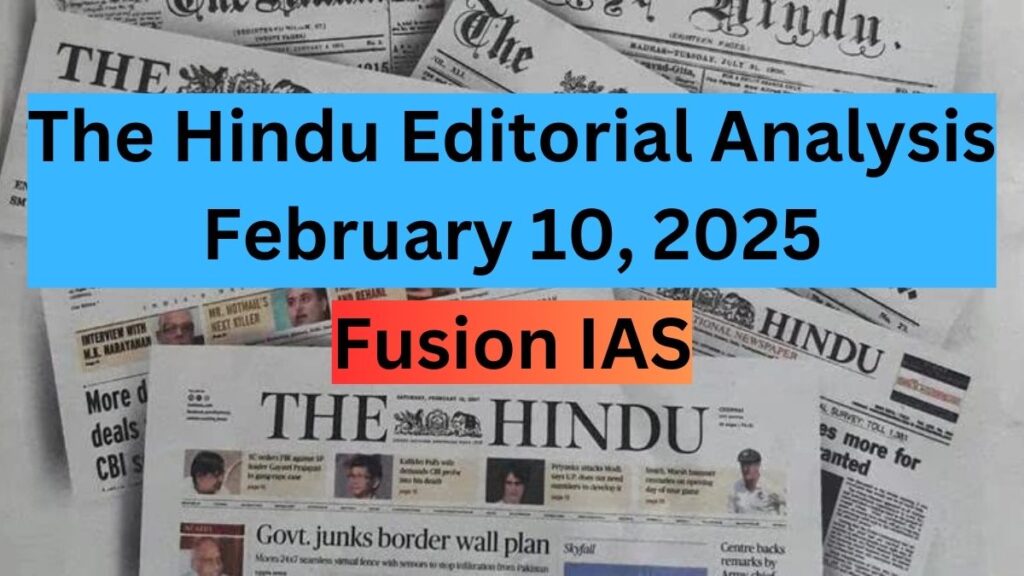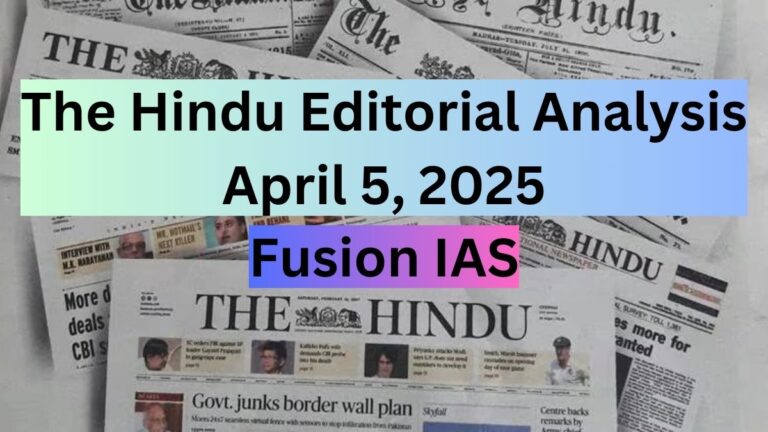
The Hindu editorials are a crucial resource for understanding key national and international issues. This analysis simplifies complex topics, highlights key points, and offers critical insights, making it an essential tool for competitive exam preparation like UPSC CSE and developing a well-rounded perspective on current affairs.
1. Common man’s revenge: on the Delhi Assembly election result
Context:
The Delhi Assembly election results have marked a significant political shift, with the Bharatiya Janata Party (BJP) returning to power after 26 years and the Aam Aadmi Party (AAP) facing a dramatic collapse.
Key Points:
- BJP’s Victory and AAP’s Collapse – The election results signify AAP’s decline rather than BJP’s expansion. BJP regains power in Delhi after 26 years.
- BJP’s Pre-existing Control Over Delhi – Since 2014, BJP has maintained strong influence in Delhi through the Lieutenant Governor, municipal corporations, Delhi Police, and central ministries. It has also won all seven Lok Sabha seats in three consecutive general elections.
- AAP’s Initial Rise and Decline – AAP gained popularity as an anti-corruption movement appealing to the middle class but later became associated with reckless populism, political cynicism, and deteriorating governance.
- Corruption Allegations Against AAP – AAP’s credibility suffered due to serious corruption allegations, including the revelation that Arvind Kejriwal spent ₹52.7 crore of public funds on refurbishing his official residence.
- Implications for BJP’s Governance in Delhi – BJP’s victory presents an opportunity to improve infrastructure, civic amenities, and governance, further consolidating its influence in the Hindi heartland.
- Setback for Kejriwal’s National Ambitions – Arvind Kejriwal’s efforts to position himself as a national alternative to Prime Minister Narendra Modi have suffered a major blow, and his attempt to secure a captive Muslim voter base has failed.
- Impact on the Non-BJP Opposition – AAP’s downfall weakens the assumption that the 2024 general election results signified a fundamental shift against BJP, necessitating a strategic reassessment by opposition parties.
- Congress and the INDIA Bloc – Congress, despite failing to win in Delhi, may see AAP’s defeat as a potential advantage but also faces challenges in leading the INDIA bloc due to its inability to unite opposition forces against BJP.
2. India’s opportunity at the AI Action Summit
Context:
India is set to co-chair the AI Action Summit in Paris on February 10-11, 2025, following similar summits in the UK (2023) and South Korea (2024). The summit will focus on AI safety, innovation, public interest AI, and AI governance. This presents India with an opportunity to advocate for the Global South by pushing for equitable AI access, contextual AI safety measures, and frameworks tailored to the unique needs of developing nations. India’s leadership at the summit could also strengthen its bid to host the next AI Action Summit, reinforcing its role as a bridge between the Global North and the Global South in AI development.
Key Points:
- India’s Role at the AI Action Summit – India is co-chairing the summit, giving it a strategic position to shape discussions on AI governance, innovation, and safety, particularly from the perspective of the Global South.
- Previous AI Summits and India’s Engagement – The UK summit (2023) focused on frontier AI safety, and the South Korea summit (2024) expanded to multilateral AI risk management. India has been an active participant and is also planning to establish an AI Safety Institute.
- Advocacy for Global South – India has consistently championed AI access for developing nations, as seen in its 2023 G20 presidency and the Global Partnership on Artificial Intelligence (GPAI) meeting.
- Priority: Democratizing AI Access – India must push for equitable AI resources, including computing infrastructure, cloud platforms, foundation models, and open-source AI tools. It should also promote distributed computing solutions and policies for flexible cross-border AI technology transfer.
- Priority: Developing AI Use-Cases for the Global South – India should advocate for AI applications tailored to local challenges, such as healthcare diagnostics, personalized education platforms, and agricultural tools. A Global South AI use-case repository could be created to guide AI development in these regions.
- Priority: Contextualizing AI Risks and Safety Measures – AI risks in developing nations differ from the Global North. India should emphasize cultural preservation (mitigating biases in AI models trained on Western data) and advocate for evidence-based AI risk mitigation strategies tailored to the Global South.
- Strategic Benefits for India – By leading AI discussions for developing nations, India can position itself as an AI governance leader and a bridge between the Global North (AI superpowers) and the Global South (developing nations).
- India as a Future AI Summit Host – A strong presence at the Paris summit could help India secure the opportunity to host the next AI Action Summit, ensuring sustained focus on the Global South’s interests in AI.
3. An aerospace expo to further India’s global presence
Context:
Aero India 2025, held at the Yelahanka Air Force Station in Bengaluru from February 10-14, is a premier aerospace and defence exhibition aimed at bolstering India’s global presence in the sector. The 15th edition of the event focuses on technological innovation, strategic alliances, and self-reliance in defence production. Under the leadership of Prime Minister Narendra Modi, India seeks to strengthen its aerospace manufacturing capabilities, promote indigenous defence production, and attract global investment. The exhibition will showcase cutting-edge advancements, including fifth-generation aircraft and innovations from Indian start-ups, reinforcing India’s commitment to ‘Make in India’ and ‘Aatmanirbhar Bharat.’
Key Points:
- Significance of Aero India 2025 – The event is more than an exhibition; it is a platform for strategic partnerships, technological advancements, and India’s rise as a defence and aerospace manufacturing hub.
- Growth of the Event – Since its inception in 1996, Aero India has evolved into one of the most important global defence expositions, attracting leading defence manufacturers, policymakers, and industry leaders.
- International Participation – A total of 106 Original Equipment Manufacturers (OEMs), including 55 foreign OEMs from 19 countries (such as the U.S., Russia, France, Japan, and Israel), along with 16 Defence Public Sector Undertakings (DPSUs) and 35 Indian OEMs, will showcase their advancements.
- Major Highlights – The event will feature two of the world’s most advanced fighter jets, the Russian Su-57 and the American F-35, marking India’s growing role in global defence diplomacy.
- Indigenous Defence Capabilities – India will exhibit a model of its fifth-generation stealth fighter aircraft, the Advanced Medium Combat Aircraft (AMCA), which has 75% domestic content, signifying India’s self-reliance in advanced military technology.
- Focus on Start-ups and Innovation – ‘Manthan,’ a dedicated platform at Aero India 2025, will showcase pioneering innovations from Indian start-ups under the Innovations for Defence Excellence (iDEX) initiative, promoting indigenous technological solutions.
- Visitor Experience Enhancements – Infrastructure improvements such as expanded roads, enhanced transport services, a multi-tier security strategy, better amenities, and a real-time navigation app will ensure a seamless experience for over seven lakh visitors.
- Strategic Implications – The event underlines India’s ambition to be a global leader in defence manufacturing, bridge technological gaps, strengthen international partnerships, and boost the domestic aerospace sector.
- Aatmanirbhar Bharat and Make in India – The exhibition reinforces India’s commitment to self-reliance in defence, with a strong emphasis on indigenous production and reducing dependence on foreign technology.
4. Keeping a watch on the growing arc of violence
The article highlights the growing threat of terrorism, emphasizing the resurgence of groups like al-Qaeda and ISIS. It discusses how these organizations are evolving, leveraging digital platforms for radicalization and recruitment.
Key Takeaways:
- Global Security Landscape – The world is experiencing increasing violence, particularly in Europe and West Asia, challenging international peace efforts.
- Failure of Global Institutions – The UN Security Council and the International Court of Justice appear ineffective in addressing ongoing conflicts, signaling a breakdown of the post-1945 world order.
- Evolving Nature of Terrorism – Terrorism is adapting to modern technologies, with radicalization happening online. The idea that Islamist terrorism is weakening is misleading.
- Historical Context – The rise of modern jihadism can be traced back to 1979, with Sunni radicalization (al-Qaeda, ISIS) and Shia militancy (Iran-backed groups). Both sought to challenge pro-Western regimes.
- Current Trends –
- Resurgence of al-Qaeda and ISIS: Al-Qaeda has resumed training in Taliban-controlled Afghanistan, while ISIS-K (Khorasan) is expanding operations.
- Global Spread: Terror activities have been reported in Russia, Iran, Türkiye, Pakistan, Bangladesh, Malaysia, Singapore, and Thailand.
- West Asia’s Changing Politics: Arab states are prioritizing national interests over collective jihad.
- Recent Terror Incidents in the U.S. –
- Las Vegas Attack: A Tesla Cybertruck explosion near a hotel where Donald Trump was staying.
- New Orleans Attack: A truck attack by an ISIS-inspired individual, killing 14 people.
- Foiled Attack in Virginia: U.S. intelligence agencies intercepted a planned terror strike.
- Counter-Terrorism Concerns – The use of artificial intelligence for recruitment and planning terror attacks is a rising challenge. Security agencies worldwide must prepare for a potential new wave of terrorism.
Conclusion:
The resurgence of terrorism, combined with geopolitical instability, demands urgent global counter-terrorism measures. The warnings must be heeded to prevent a new era of large-scale attacks.
5. A gift horse’s teeth: on allocations and scientific research
The article discusses India’s increased budget allocation for scientific research while highlighting structural challenges that could hinder its effectiveness.
Key Takeaways:
- Budget 2025-26 and Science Funding:
- ₹20,000 crore allocated for small modular reactors, aiming for five operational units by 2033.
- Creation of a Research, Development, and Innovation Fund under the Department of Science and Technology (DST).
- Total DST budget raised to ₹28,000 crore—three times last year’s allocation.
- Challenges in R&D Investment:
- Private sector participation remains low, contributing only 36% to total R&D spending.
- India’s R&D spending in 2020 was 0.64% of GDP, the lowest since 1995.
- Public sector R&D units allocate only 0.30% of sales turnover, while private sector R&D spending is 1.46% (2020-21).
- Concerns Over Absorption of Funds:
- Despite strengths in IT, pharmaceuticals, metallurgy, and biotechnology, India’s core R&D output remains weak.
- Key gaps:
- Lack of essential infrastructure (chipsets, semiconductor fabs).
- Shortage of a skilled workforce in advanced technologies.
- Weak innovation ecosystem and industry-academia collaboration.
- Need for a Clear Strategy:
- The government must define how private players can access these funds.
- Funding alone is insufficient—structural reforms, incentives, and long-term industry engagement are essential.
- Focus should shift towards strengthening foundational R&D infrastructure to ensure sustainable innovation growth.
Conclusion:
While the increased allocation is promising, without addressing systemic challenges, India’s ambition of becoming a global research hub may remain unfulfilled. A clear policy roadmap and stronger private sector engagement are crucial for success.
Disclaimer:
This analysis is based on the editorial content published in The Hindu and is intended solely for informational and educational purposes. The views, opinions, and interpretations expressed herein are those of the author of original article. Readers are encouraged to refer to the original article for complete context and to exercise their own judgment while interpreting the analysis. The analysis does not constitute professional advice or endorsement of any political, economic, or social perspective.
Follow Fusion IAS


